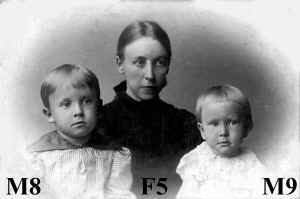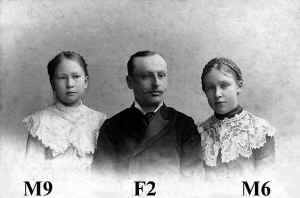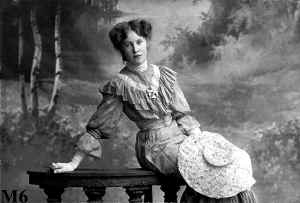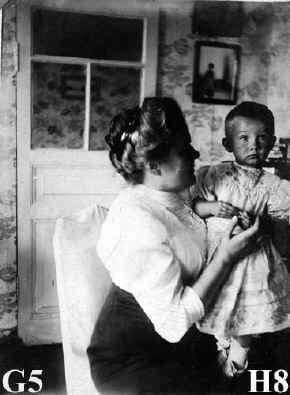FATE OF SANCT-PETERBOURG KINS KLOSSE and MÖLLER
Hypothetical founder of the kin, 0A, is mentioned in Archives at the end of
18th c. This Johann Christopher
Klosse (1778-1835) is registered in the history of Tzarskoe Selo as a
druggist who prescribed medicines for the Lyceum there (among others - for
future Russian poet Alexandre Pushkin). His career from Geselle to druggist, as
well as his conflict with Franz Peschel, therapeutist of the Lyceum, are well
reflected in archive documents (Historical Archives of Leningrad Oblast,
IALO, store 185, inventory 1, files 130, 265, 518, 618, 719, 790; inventory 2,
files 48, 109; store 11, inventory 1, files 15,
256; Central Historical State Archives, CGIA, store 487, inventory 4,
files 150, 151 ).
0A opened the town drugstore in 1812 (11-1-15). It was located against wine
cellars (487-4-152, sheet 17). Its appearing was a blow to the
drugstore of the Lyceum, which was closed. The strongest attack on 0A in order
to discredit and ruin him was organised in 1830 and carried out by State
Councellor Dussik, Acting Staff Physician. The aim was to close the
town drugstore.
This attack failed because A0 was defended by Artillery
Lieutenant-General Jakov Zakharzhevsky, the Governer of Tzarskoe Selo.
Nevertheless, the strained struggle against injustice shortened 0A's life (the
last revision was carried out in February, but he died in October, 1835).
Documents show him having been a considerably poor person who could exist only
subsidised by the state. He died as a Titled Counsellor and was buried in a
Lutheran section of Kazan Cemetery in Tzarskoe Selo (data from Sct.-Peterbourg 'Necropol' edition). No grave preserved, the cemetery having
been fully devastated by ethnic Russian hooligans and with later Soviet burials
after 1917.
According to archival data obtained by youngest representatives of the
kin, all of them come from Johann Christopher Klosse, 0A.
His wife was Catharine Augustine Klosse née Schwertz, A0, born in 1777,
died on January 25, 1839, in
As seen, all further mentioned generations of Klosse come from Constantin.1
(1805–1859), AC, Klosse, the son of 0A, i.e. “Titled Counsellor Khristofor Ivanovitch Klosse”, i.e. 0A.
Constantin.1 (AC)'s son Constantin.2 Friedrich, B1, Klosse married his
cousin Laura, B4, daughter of Paul Möller, A4,
and Clara Möller (née Klosse), A5. This origin of
Laura is seen from her record
made in the
diary of CK (former maiden Album of her mother Clara Klosse, A5). As
for her blood relationship with her husband Constantin.2 Friedrich, B1, this is
seen from a record of March
25, 1858, made by the latter in the maiden Album of Laura, i.e.
“your cousin K. Klosse“ in
Russian. B1 (Klosse) being Laura’s cousin, Laura’s mother’s birth surname
being Klosse too, Laura’s mother Clara had to be a sister either of Laura’s
husband’s father, or of Laura’s husband’s mother. However the latter
originated from the kin of Rausch, not Klosse. This means that Clara was a
sister of Laura’s husband’s father, AC.
A 16 years difference between the birth of Constantin, AC,
in 1805, and that of Clara, A5, in 1821, means that
either Johann Christopher, 0A, and Catharine Augustine,
A0, had many children (part of them having probably died at their nonage), or
that Catharine Augustine was a second wife of Johann Christopher, i.e. that he
had widowed not earlier than in 1805, but married for the second time not later
than in 1820.
Constantin.1
Klosse, AC, (1805-1859),
a Lutheran, was born in Sanct-Peterbourg. He had graduated from the
On August 20, 1839, he married Friderike Richter, AD, née Rausch.
He was promoted College Counsellor in 1844.
While being a bearer of Orders of St. Ann of the 3rd degree and of
St. Vladimir of the 4th degree, on May 18, 1846, he appealed for a conferment of
nobility in accordance with articles 19, 39, 39 of the 9th volume of
the 1842 Summary of the Russian Empire Laws, as well as with point 6 of the
Emperor’s Manifesto of June 11, 1845. A resolution of the 3rd
executive department of the Heraldry Service on preparation of a corresponding
nobility diploma followed on September 15, 1846. In 1847 AC applied
to Emperor Nicolas I for presenting the diploma.
AC was promoted State Counsellor in 1849, so that his nobility was
hereditary according to current laws. According to the order of the Heraldry
Master of August 4, 1851, a snake winded itself round a sword (what was a symbol
of military medicine) and a crescent (what was a sign of participation in a
Russian-Turk war) made up Coat of Arms of Klosse.
Constantin.1 Klosse died in Tzarskoe Selo being 54 years old. He was buried in
Tzarskoe.
Constantin.1, AC, and Friederike, AD, Klosse had two children: a son Constantin.2 Friedrich, B1, and a daughter Helene Alexandra (Lilyusha, 17.05.1842 - 20.04.1868), B2, who married Jean (von) Molochowetzt on 14 October 1865 (not to be taken for Helene von Molochowetz, née Burmann, 1831-1918).
Last known Klosse in
The name Klosse itself does not point out to any nobility. This surname
is known in
Nevertheless there is no ground to suspect descendants of B1 having violated
traditions with the insertion of the particle ‘von’ before their
surname.
The thing is that according to a registry found by the youngest Klosse, there
lived Gottlib von Klosse in Tzarskoe Selo, who died there on August 13,
1839. An existence of a person of the same so rare surname seems to be
incredible in so small town as Tzarskoe. More likely that Gottlib von Klosse was
one descendant of Johann Christopher Klosse, 0A, more, who had achieved a
nobility in his turn.
It is interesting that a name of a pupil
druggist Theodore Kloss (the name Klosse also occurring misspelled in this way) is mentioned in the same archive documents of 18 October
1804 (IALO, 185-1-146, file No. 104, 965) asking for the certifying exam of a Geselle
degree (0A had been already a Geselle
in October because he was mentioned as such to become certified druggist on 2
August - 27 September 1804 - cf. IALO, 185-1-130). The spelling Kloss instead of Klosse
should have occurred due to much bigger frequency of the name Kloss
in comparison with Klosse. However it
seems incredible that somewhere in Sanct-Peterbourg two pupils began a career of
a druggist at the same place and time.
First Klosse were closest
related to Möller. The latter are
considered to be Baltic Germans in their turn.
Paul Möller
(35.05.1807-26.01.1886), A4, who also was a druggist from Tzarskoe Selo
too, is best known. As one can
conclude from the above-mentioned archive documets (CGIA, store 487, inventory
4, file 152), he succeeded 04 at a town drugstore as a provisor after 0A's death
on 3 October 1834. 3 years later, in 1837, he married Clara Klosse, A5, who was born in 1821 and was probably a daughter of 04.
Clara Möller née Klosse and Paul Möller
All known data about the relationship between Klosse and Möller come from record made by Laura, B4, daughter of Clara and Paul, in the diary of CK (former maiden Album of her mother Clara Klosse, A5).
Paul Möller, A4, rejected further exploitation of the 31 years old wooden town drugstore and his expensive state flat there in order to be allowed to buy a brick house in the Centre of Tzarskoe Selo (corner of Moskovskaya and Konyushennaya str.) for 20,000.- Roubles (CGIA, 486-6-339) in 1844. The last possessor of this house, as well of the Town Drugstore consequently, was Alfons Döhringer (father of a known motorist Alfons Döhringer), who seems to have been married Helene, B5, the youngest daughter of Paul Möller (cf. further).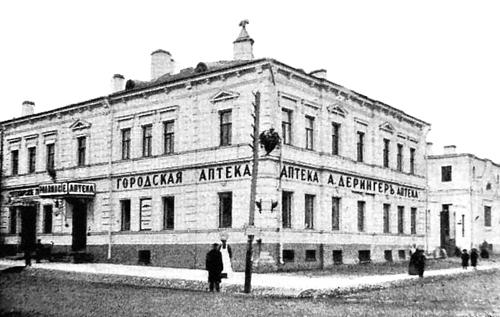
Paul Möller, A4, was the third child of Filipp Möller, A0,
whose first son was
Hermann, born 1801, but the second was daughter Helene, born 1804. Hermann and
his wife Louise (died 1869) had 11 children. Of these children twins Bernhard and
Max, born 1837, as well as Marie, born 1863, are worthy to be mentioned here.
Max wrote beautiful German poems (one
finds them in a maiden Album
of Laura, B4), but Marie, and later her
husband Ernst Lenz, were often guests in the family of Paul Möller's daughter
Laura, B4, and her husband Constantin.2 Klosse. Paul Möller's sister Helene
married Ottomar Peltz (died 1864). Their descendants were close to descendants
of Laura and Constantin.2 Klosse in their turn.
Paul Möller, A4, remained constant resident of Tzarskoe Selo up to his
death. Several relics survived after him and are kept by the family of Q3 in
Kaunas. Among one sees a cigar-knife,
a library of the German edition of Fr.Schiller's and
W.Schakespeare's works, books about Friedrich the Great and Napoleon with A4's signature, as well as his
memorial
inscription in the diary
CK (former Album of Clara Klosse,
A5) of his daughter Laura, B4. A4 was buried in the
Lutheran section of Tzarskoe Kazan cemetery, fully destroyed by ethnic Russian
hooligans as well as with later Soviet burials after 1917.
Paul, A4, and Clara, A5, Möller had 1 son (the
eldest child) Constantin-Julius, B0, born in 1838, and 4 daughters: Laura
Helene,
B4, later - Klosse, born in 1839, Angeline, B6, later - Pormann, born in
1840, Catherine, B7, later Metz, born in 1844, and Helene, B5, born in 1849.
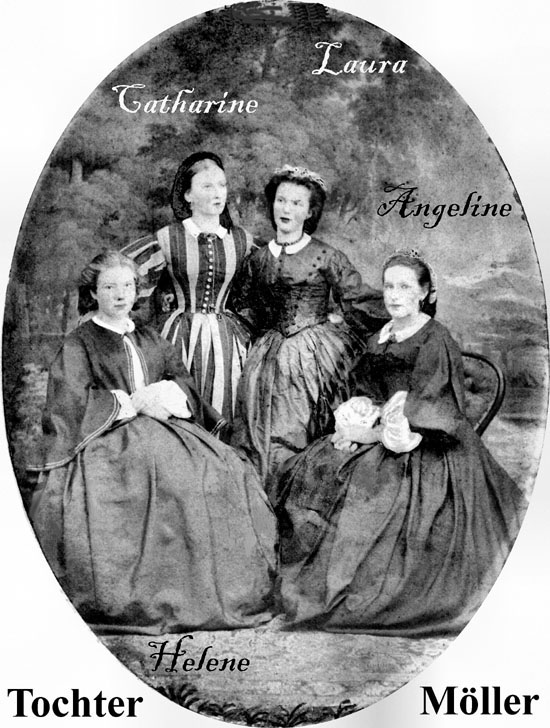
Helene, Catharine, Laura
and Angeline Möller.
Constantin-Julius Möller, B0, was obviously brought up by his father to continue the latter's work at the drugstore in Tzarskoe Selo. Unfortunately, the youth appeared to be corrupted - he began to play cards and finally got into a debts prison. There, in November 1858, he wrote his repentence letter, in which he mentioned a goblet, presented to him by his uncle Klosse (AC, who died in 1854 and who was probably uncle and husband of Friderike, sister of Constantin-Julius' mother Clara?), as well as K.Klosse (cousin Constantin.2 Klosse, B1?), living on Basily's Island in Sct.-Peterbourg (Vasilyevsky, real name Elks', Hirvisaari, was a traditional region of Peterbourgians of the German origin). B0 tells how he visited his sister Laura, B4, in Tzarskoe Selo late in the night, awaiting her in the garden to bring him his family silver. Of this silver 3 spoons with the initials CM 1838 are still kept by Q3 and his family in Kaunas, Lithuania. B0 also tells how he pawned his diploma for the debts. Of course such things were as horrible as thunder for his highly decent German father. No doubt, Paul Möller, A4, deprived his son of any legacy. After the death of A4 some alien person with a German name is indicated as a druggist at former Möller's drugstore in Tzarskoe Selo. No data about the fate of Constantin-Julius have been preserved. Besides the repentence letter, his 2 German verses have remained, put down by him into the maiden Album of his sister Laura, B4, on 27 March 1858.
Of A4's daughters Catharine, B7, remained close to Klosses and was godmother (then married to Georg Metz) of her niece - sister Laura (B4)'s daughter Marie, F7, further wife of Gregory Tarasenko, F8.
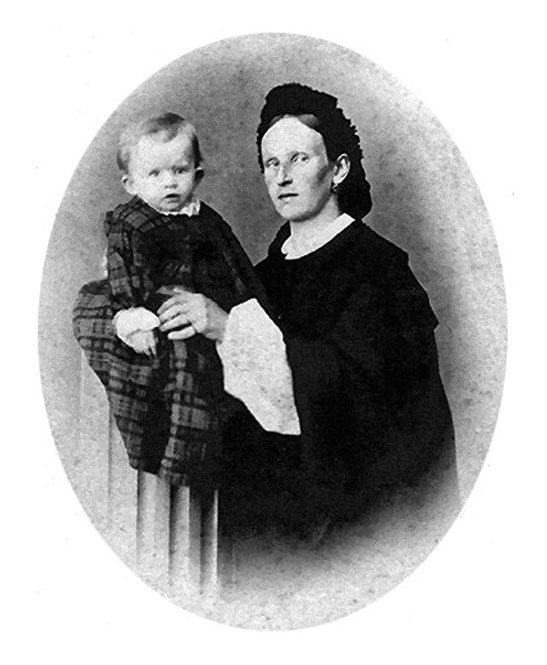
Catharine Metz née Möller with her daughter Catharine
Laura Helene Möller > Klosse (1839 - December 1908), B4, the eldest daughter of Paul Möller, A4, and his wife Clara, born Klosse, A5, is the central figure uniting the kin of Möller with those of Klosse and Tarasenko.
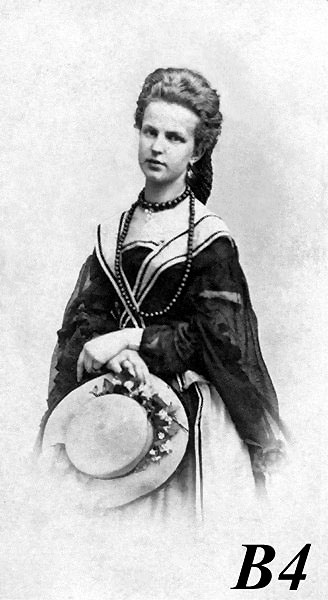
All data about Laura are gathered from narrations of her granddaughter H8 and
grandson M4, as well as from her own maiden Album,
notes and photos. In 1863 she married her cousin Constantin.2 Klosse, B1, who
was a constant resident in Novgorod. Their relationship is evident from the postscript "Your
cousin K.Klosse" below a Russian verse put by Constantin
Klosse into the Album of Laura Möller on 25 March 1858. After the marriage they moved to Novgorod where
B1 made his successful career. It is not known whether it was their first house,
of which B1 writes to his mother AD on 14
March 1862 about the arrangement of
his future family flat in Novgorod. In any case, when he had already become Real
State Counsellor and inspector of Novgorod gymnasium-schools, he ought to live
in the centre of the town.
Nevertheless, B4 purchased for themselves a big brick
house in a remote place, on 14, Slavnaya Str., on the other side of Volkhov on 23
May 1886.
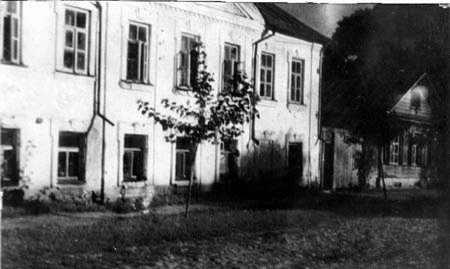
The brick house No14 on Slavnaya str. (the north-western frontage). Further the wooden house No 12 of Tarasenko is seen. Photo of 1939 (?) when the brick house had been already nationalised by the Bolsheviks and Klosse did not dwell there.
The sense of the purchase might have been the coming marriage (in 1887) of their eldest son Paul, who had to inherit his father's possession. With all probability, the old house was presented to Paul but his parents, B1 and B4, moved to the new house on 14, Slavnaya Str. A nearby one-storey wooden outhouse was on the same plot farther from the street.
The wooden outhouse which belonged to
Constantin Klosse after the nationalisation.
Koka Ekimov is seen sitting on
the balcony on the south-western side. 1939 (?).
On the left the back
(north-eastern) side
of the brick house (with a wooden annex) is seen.
Family legend tells that B4 split with her husband in the
last years and they lived separately: she did not talk to B1 and was in the outhouse while B1 dwelled in the
main house.
There might have been several reasons of this quarrel. First, their daughter
Marie changed her Lutheran
confession to the Orthodox one by free will in 1893. Secondly, B4 refused to consent
to marriage of her son Constantin.3 Klosse, F2, with a common Russian woman. In 2 years, in
1900 a boy Nicolas, M4, was born of this liaison, and a girl Elisabeth, M3,
after that. Although this happened already after the death of B1, the beginning could be
a reason for a quarrel between B4 and B1: the latter all his life made a Russian
career and even did not use the German language in his youth. Therefore he was
more "Russian" and more democratic than his stern wife. It seems that
Laura finally regarded her husband to be the cause of all possible disasters, as
it often happens to many wives.
This quarrel contributed to the early death of B1 which was a result of a much
more heavy blow: at the very beginning of 1898 the dearest son of B1 died
- Paul Klosse.
After the death of her husband Laura settled the wooden house on her son
Constantin, F2. The brick house and the wooden
outhouse were presented to him in 1899.
The husband, B1, was still living when Laura, B4, broadened her possessions by purchasing a neighbouring wooden house on 12, Slavnaya Str., from Elena Vaulina in 1888. Afterwards, in 1905, the house on 12, Slavnaya Str., was presented to her daughter Marie, F7.
The south-eastern side of the wooden outhouse.
From the left: widow Maria Klosse née Henkel, Martha and Koka Ekimov. 1939 (?).
Farther
on the left: the garden side of Tarasenko's house
(purchased by Laura Klosse
from Vaulina
and presented to her daughter Maria).
During all this period B4 used to spend at least part of the year in Sct.-Peterbourg where her addresses varied, as seen from the 'All Sct.-Peterbourg' address-books of 1896 (13, Sadovaya str.), 1897 (21, Pryadilnaya str.), 1898 (already pointed out as a widow, 5, Konnaya str., flat 3), 1899, 1900, 1901 (63, Nevsky ave.). The houses in Novgorod began to be used as summer residences. Both wooden houses in Novgorod burnt down during the World War II, but the walls of the brick house remained up today:
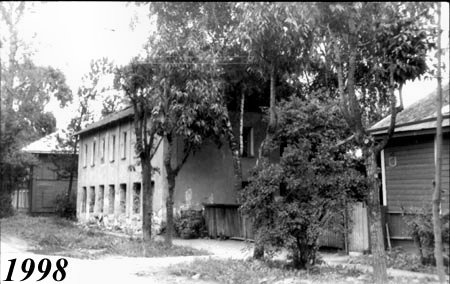
Remnants of the brick house No 14 on Slavnaya
str. No 12 lacks (a new house on the right is No 10).
A photo by Constantin Ekimov, Letas Palmaitis and Josepha Palmaityte.
Laura, B4, having not acknowledged "illegitimate" children of her son F2,
compensated this with her love to the children of her daughter F7 - Anatole Tarasenko, N2, born
in 1898, and Eugene Tarasenko, N3, born in 1900.
Laura Klosse née Möller, B4, and Constantin.2
Klosse, B1, had 6 children, 3 of whom died in childhood (see further). B4 was buried
above the latter, just as she had dreamt in her diary (see further), on the
Lutheran cemetery in Novgorod. The cemetery was
destroyed during shelling in World War II.
Constantin.2 Friedrich Klosse (June 2, 1840 - 1898), B1, ended his career as Real State Counsellor, Inspector of Novgorod gymnasium-schools in spite of his being a Lutheran. His letter to his mother Friderike Klosse, AD, 14 March 1862 during the arrangement for his 1863 marriage with Laura Möller, B4, is written in Russian. The same is his inscription in the maiden Album of B4 on 25 March 1858, one of a few Russian inscriptions in this Album. It is not excluded that he was taught to make a Russian career by his parents, nevertheless the inscription in the German Album, when he was only 18 years old, with more probability shows that his native language was Russian, not German. On the other hand, the contents of the letter 1862, in which a Lutheran Pastor is mentioned in connection with the announcement about coming wedding in the Church, shows him having been a Lutheran. Not so language as a confession was important in making state career in Czarist Russia. One may imagine a long years history of his love to his cousin B4 before he finally married her. The whole year arrangement of the wedding (if such delay was not due to obstacles caused by their relationship) as well as some restraint in the attitude of B4 herself to her bridegroom (see the letter) on the eve of the wedding, might have been a result of B1's Russian orientation. If such really took place and was one of the reasons of his successful career, it was later compensated, over the full measure, by his sons Paul, F4, and Constantin.3, F2, who titled themselves 'von Klosse'. In any case, B1 could not be illiterate in German, spending all his life among the German-speaking relatives and having a German-brought-up Lutheran wife.
B1 and B4 had 7 children: Laura, born and died on 3 November 1863, Woldemar Leonard (January 20, 1864 - November 23, 1864), Paul (1865-1898), F4, Elvine-Helene (April 7, 1868 - ca. 1878), F6, Laura-Elvine (August 18, 1870 - ?), Marie (1871-1922), F7, and Constantin.3 Alexander (1873-1939), F2.
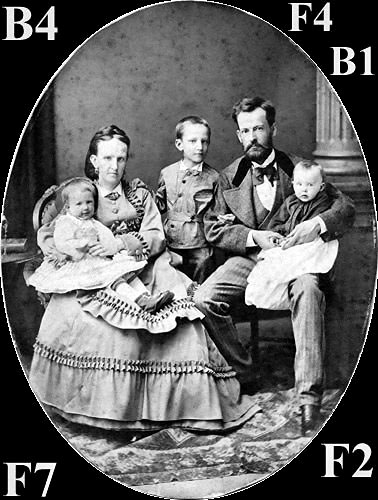
Marie, Laura, Paul, Constantin.2, Constantin.3 Klosse.
Only one, the youngest of these 6 children, enjoyed a normal life of 66 years. Women usually live longer than men, therefore Marie's 51 year is a very short life, not to say about 33 years of Paul. Only 2 children survived their parents, Marie and Constantin.3, i.e. the spouses buried 4 their children during 35 years of common life. No wonder, that Laura, B4, put down in her diary CK (once - Album of her mother Clara Klosse, in marriage - Möller), that her greatest dream was to be buried over her children. B1 accused the medicine of the death of his children (Woldemar and Elvine-Helene seem to have died of diphtheria). Of these children he especially loved Paul whose early death was the main reason of his own death. Paul really was very similar to his father even superficially. As for the 2 children who had survived their parents, their life was neither long, nor happy. Constantin.3, F2, experienced tragedy of his love to a woman who was rejected by his mother and finally committed suicide. One of 2 their illegitimate children, a daughter, died in childhood of a disease, probably inherited from her father. The life of Marie, F7, was short (51) and her last 5 years after 1917 were hard and ended in poverty. F7 had also problems with her impulsive Ukrainian husband F8, while their daughter H8 also lived short (58) but the life of Q3, son of the latter and great-grandson of B1 and B4 (Q3 deliberately took the name Klosse-Klussis as his pseudonym), is highly disorderly and inadequate. Theodore, the single child of Paul, F4, died young, similarly to his father, but he even left no descendants. As for his sister Eugenia, she died in childhood. All this, including the final divorce of Laura, B4, and Constantin, B1, may only mean that God did not bless their marriage which must be regarded ill-fated. Even their graves and graves of their young children were destroyed during World War II.
Seeing constant disaster in his family, B1 explained this as fault of the physicians and began to hate them and official allopathic medicine. In his last years he wrote an amateurish pamphlet Pora znat, kak izbavit'sya ot dorogikh vrachey i aptek ('It is just the time to know how to get rid of expensive doctors and drugstores'), in which he popularised a method by German peasant Johann Schrott of natural healing by air, diet, clyster, compresses and swaddling the patient into hot moisted bed-sheets.
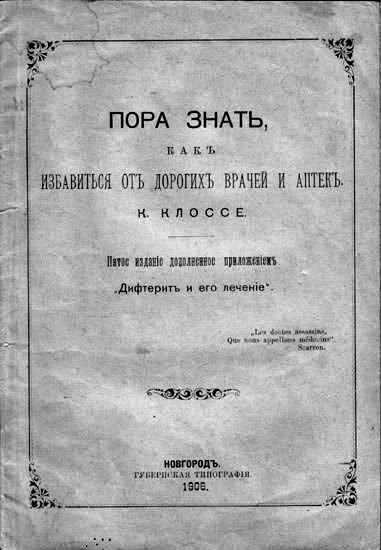
After the death of B1 this
pamphlet was for the 5th time published by Paul's son Constantin.3 Klosse,
F2, in Novgorod in 1906. Later F2
lost his own daughter M3 due to following the recommendations of his father. Up to the
World War II, i.e. as long as the Novgorod wooden outhouse survived, there were
a lot of unsold exemplars of the pamphlet scattered on the loft upstairs. They
burned away together with all rests of the estate of B4 during the war.
B1 was buried on the same Lutheran Cemetery in Novgorod, as later his wife B4
too. Their graves were destroyed during World War II.
Paul von Klosse (April 10, 1865 - January 3, 1898), F4, was mostly loved by his father and distinguished himself with striking resemblance to him.
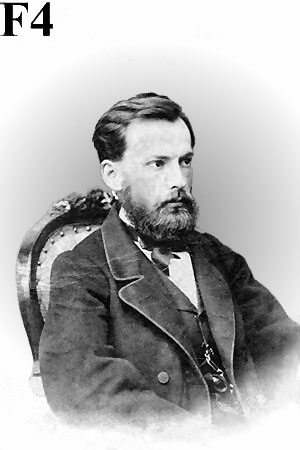
After finishing studies in economics, F4 became a bank official engaged at Peasants' Loan Bank (his last address on his last 2 days on 1-2 January 1898 was 5, Konnaya str., flat 9, according to 'All Peterbourg', 1898). F4 died 5 days after celebrating the 10th anniversary of his marriage.
This was on 28 December 1887 when he married Therese Wilhelmine Hamnerin (1865-1950), F5, born in Helsingfors (Helsinki), whose father was Wilhelm Hamnerin (1829 in Amsterdam -1903 in Helsingfors) but whose mother was Augusta Therese, born Ulfsax (1832 in Haapsalu, Estonia, - 1905 in Helsinki). As it seems from the date of marriage of her parents (1860), F5 was not their first child, i.e. she was not the single child. Her mother's name Ulfsax with all probability shows descent from some Livonian knights of the Saxon origin. A Finno-Ugrian appearance of the daughter of F5 Eugenia-Concordia, M9, shows her mother Augusta Therese having had Estonian or Finnish ancestors too. In any case, the first child of F4 and F5, Constance, was born in Tallinn (Reval).
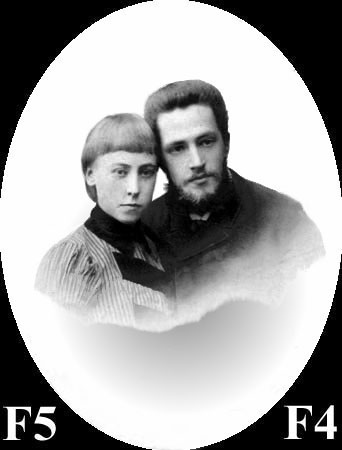
The marriage of Paul, F4, and Therese, F5, in 1887 marked the beginning of the
Finnish branch of Von Klosse, which unfortunately ended with
the early (at the age of 44) death of their single son Theodore, M8, who left no
descendants. No of her children survived when Therese von Klosse died in
Helsinki on 14 November, 1950, leaving no descendants after her. No need came
out of successful adding of the noble particle von to the name Klosse:
there were no more persons to be named with this von. The malediction of
the marriage of B1 and B4 was still in force.
In memory of Therese von Klosse, F5, remain 2 photos and her postcard
written to her mother-in-law Laura, B4.
F4 and F5 had 3 children: Constance Adelheid Laura (Stania, 1889-1942),
M6, Theodore (1891-1935), M8, Eugenia Concordia Valentine
(1893-1910), M9.
Theodore, Therese, Eugenia.
M6 was born in Estonia, but M8 and M9 were born in Novgorod,
where all of them spent their childhood in the old house of B1 till the death of
their father Paul von Klosse, F4, in 1898. Then their mother F5 took them to her
native home on 23, Petrovskaya (Peeteri?) str. in Helsinki. No doubt,
their native house, i.e. the old house of B1 in Novgorod, still belonged to F5
as heritage of her husband F4 at least up to Bolshevik nationalisation campaign
after 1917.
Of these children Eugenia,
M9 died at the age of 7, but Theodore, M8, made his career in Finland. On
8 July 1917, after the February revolution but before the Bolshevik revolt, he
married a 19 year old gymnasium schoolgirl Greta Alekseev, daughter of a
post-expeditor from Sartavala (she had been born there in 1898). This
schoolgirl Greta appeared to be an extraordinary devoted wife who remained single
after the early death of her husband in 1935 up to her own death in Helsinki on
15 April 1984.
After the death of Paul von Klosse, F4, his brother, the violinist Constantin.3 Klosse, F2, took care of his nieces M6, M9 and nephew M8 as he only could.
Eugenia and Constance with their uncle Constantin.
No doubt this was his merit that his nephew Theodore became a
professional violinist, engaged at the Orchestra of the City of Helsinki. As said,
he died there in 1935. It is a
question, whether his uncle F2 (who had to live 4 years more) even came to know
about death of his dear nephew - the iron curtain of the Stalinist terror
divided them, and even to mention any relatives abroad was dreadful: everybody,
who was known having such relatives, risked to be declared a spy at any moment
and to be sentenced to death.
The fate of Constance, M6, was more romantic and turbulent.
Stania.
She was born in Reval (Tallinn) on 10 July, 1889. She was very close to her aunt Maria, F7, sister of her father F4. Having become professional painter, she travelled over Europe, constantly dwelling in Helsingfors, but not forgetting her native house in Novgorod too. According to Helsinki Police Address Bureau, she went to Sct.-Peterbourg and Novgorod in 1914 and 1916. Her letter of 17 July 1917, from Helsingfors to F7 in Terijoki (Soviet Zelenogorsk) on Karelian Isthmus, where F7 had her summer house after marrying F8, shows M6 going to Novgorod in September 1917 too. She writes being unable to visit F7 in Sct.-Peterbourg because she is hurrying to Pavlusia. The latter was Pavel Doroshenko, M7, a teacher of mathematics and amateur singer, in whom she had fallen in love earlier. It is not known whether she married Pavlusia. She probably wanted to take him from the Soviet Union, what was no less risky than her own several crossing the Soviet boundary to see M7. The latter was known in Novgorod due to his solo concerts at the beginning of twenties. It seems that Constance, M6, stayed by him till 1925, when she went back to her mother in Helsinki. For the last time she is registered leaving Helsinki in 1926 "for unknown direction". This had to be Novgorod again. According to H7, he saw her in summer 1926 on 14, Slavnaya Str., and recalled how she with Pavlusia, M7, himself and smb. others crossed Volkhov with a boat. She worried about M7's rowing because he was ill with epilepsy. Possibly M7 died soon. Last data about M6 come from Giesendorf, Germany, where she died on 17 August, 1942.
Marie Klosse (November 29, 1871 - July 26, 1922), F7, was the third and the last daughter of Constantin.2, B1, and Laura, B4.

She was born on 29 November, 1871, in Novgorod and baptized on 19 March, 1872, in Lutheran Church of St. Nicolas there, her godmother being Catharine Metz, B7, sister of B4. After finishing gymnasium school she studied in the Cooking School in 1892. Of her own free will she changed her confession to the Orthodox one in 1893. She was possibly influenced by her best friend Orthodox of Lutheran origin and a noblewoman Alice Kötzberg, G5, future godmother of H8.
The father of G5, Basily Kötzberg, with all probability was an Orthodox convert, as is seen from his Orthodox name. G5 was not the single factor which encouraged F7 to change her confession. With all probability this change corresponded to her ecstatic piety which could not be satisfied by rational Lutheran faith. The opportunity was her friendship with a young viola player, Orthodox Ukrainian Gregory Tarasenko (1874-1935), F8 (see Tarasenko). Marie presented her photo to him in 1895, this may be the latest possible year of their acquaintance. Their wedding took place in 1897 in the Church of the Court Stables Department in Sct.-Peterbourg.
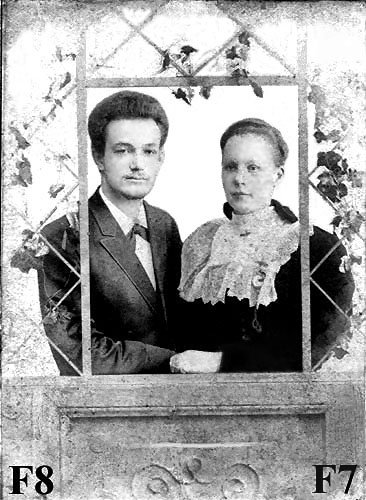
It seems enough mystical that F8, who
rented a lot of flats in various parts of Sct.-Peterbourg during his life, ended
his days in 1935 near this church on Malaya Konyushennaya Str. It is no less
strange that this was a parish church of Constantin Ekimov, C4, since
1904, but only due to the appointment of C.G.Mannerheim assistent of Chief of
the Court Stables Department just in 1897 and his being there till 1904. H7, son
of C4, married H8 (daughter of F7 and F8) who dwelled on Malaya Konyushennaya
(Sofia Perovskaya's) Str. after the death of both her parents.
Although F8 was younger than his wife, she remained the single beloved of F8 who
was devoted to her during all his life.
F8 was not pious and was even indifferent to the faith. Therefore it is not
excluded that F7 changed her confession in order to influence progress in views
of her younger friend. If so, this education was not successful. F8 remained
agnostic and pragmatic with no romanticism and a very difficult nature characterised
of impulsive paroxysms of furiousness when he could not control himself. Such
husband could not make this tender and ecstatic woman happy. During World War I
the life of the family constantly got worse unless it turned into real struggle
for the existence after the Bolshevik revolt of 1917. The famine having come, F7
got ill.
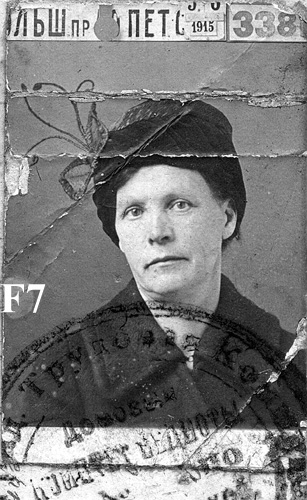
Marie Tarasenko in the years of starvation.
She died in a hospital after post-operation blood-poisoning on 26 July 1922. Her husband F8 got tuberculosis and died in 1935.
Misfortune accompanied them from the very beginning: their first baby, son Anatole, N2, born sound in 1898, was dropped on the floor and became hump-backed invalid for all his life. Their second child was son Eugene (1900-1972), N3, whose long life was not successful and marked returning from Sct.-Peterbourg back to Russia, as if a continuation of his mother's conversion in the Anti-Peterbourg direction.
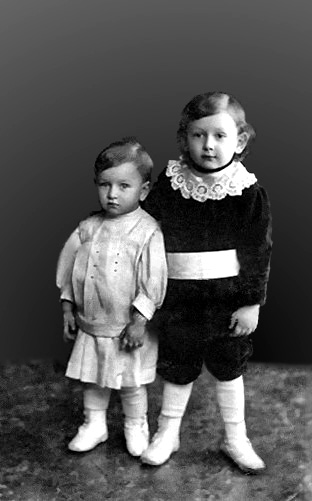
Anatole and Eugene.
Eugene, N3 ended his career as a sergeant, trumpet mayor at a military
orchestra. Died in Moscow.
The third child of F7 and F8 was daughter Tatiana (1910-1968),
H8.
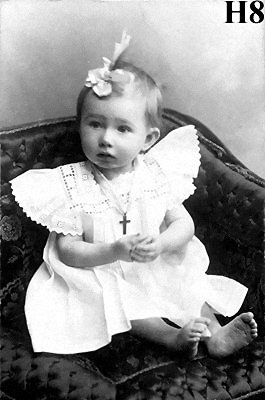
Her godparents were Alice Kötzberg, G5, and a descent nobleman Boris Alexandrovitch Mironenko, a friend of F8, an Ukrainian too, and his colleague violinist from the Philharmonic orchestra.
Tania with her godmother.
Since G5 was and remained unmarried, she loved H8 as if her real daughter.
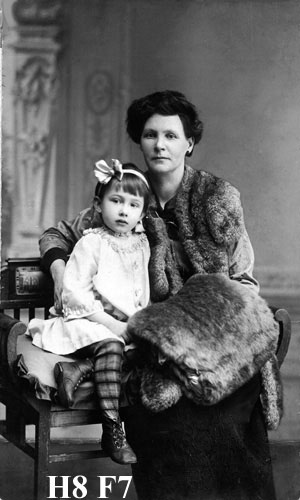
With mother.
End of the childhood as well as
adolescence of H8 were touched by starvation, but this affected her health in
following decades and shortened her life. Next starvation, suffered during the
blockade, affected the health of her son Q3. H8 lost her mother F7 at the age of
12 (1922), but her father F8 died in 1935, when she was a student (1933-1938).
In hard years of struggle for everyday existence 1917-1922, her constantly
weakening mother could not exert decisive influence on forming her convictions,
especially when her father F8 was much stronger personality with his curses and
lack of confidence in people and in Good. Under such conditions friends
of alien cultural tradition were main educators.
Good luck that her school was rearranged on the basis of former Peterschule,
in which a number of former teachers still remained. Atheistic outlook
was confirmed when studying at Leningrad
State Medicine Institute, from which H8
graduated as a physician therapeutist. Spending summers in Novgorod, in her
mother's house on 12, Slavnaya Str., she became acquainted with relatives of the
wife of her uncle, a musician colleague of F8, Constantin.3 Klosse,
F2, who also spent summers in the neighbourhood, on 14, Slavnaya Str. These were
Maria Karlovna Klosse, born Henkel, F3, wife of F2,
her sister Martha Karlovna, C5, the latter's husband Koka
(Constantin) Ekimov, C4, and their sons Basily, i7, Vladimir,
H9 and Constantin, H7. With no doubt, H8 was also guest at their
flat on 2, Bolshaya Konyushennaya (Soviet Zhelyabov's) str. in
Peterbourg/ Petrograd/ Leningrad. Although C4
and C5 thought H8 would become i7' wife, she chose the youngest
H7 who became
her fiancé since 1935. Their civil marriage took place on 18
April 1938. First the young spouses shortly dwelled in H8's room on
Malaya Koniushennaya, but soon moved to H8's uncle Constantin.3 Klosse, F2, where
they occupied one of 2 his rooms in his former 5-rooms flat on 54,
Officerskaya (after 1917 - Decembrists') str. in Colomna (F2 died in 1939).
During the war H8 and H7 remained
in the blockaged town, H8 being engaged at a military hospital in Ozerki
as a therapeutist, but H7 being engineer at Kirov (then - military)
plant.
Their first child was born and died in 1940. Their second child, son Michael (Mika), Q3, was born on 14 May 1944 soon after the end of the blockade. The boy could see rests of previous Peterbourg culture only on 2, Bolshaya Konyushennaya Str., where his grand-parents C4 and C5 dwelled together with the families of i7 and H9.
Mika with his cousin Toma as well as his cousins twins Yusha and Ina on Bolshaya Konyushennaya in 1952.
One of the most frequent words, heard there, was the word was. This was was associated with ruins of Royal summer palaces in desolated suburb parks in Paulovsk and in Tzarskoe Selo, as well as with these parks themselves. "You are not a Russian, are not a Russian!" - since childhood he remembered words of one old woman, without any purpose hurled to his nanny Maria Klosse, F3, with whom he used to walk in Alexis garden near their house on 54, Officerskaya Str. Several statues, yet not entirely broken by hooligans, were still preserved in that garden in post-war years. Once the nanny showed German captive soldiers working on a scaffolding of a repaired house. The own world in a strange way contrasted to the whole environment which gradually was perceived more and more alien. Q3 having begun to admire ruined palaces and to draw them, this was not comprehensible for his school mates, but he in his turn displeased what seemed to be interesting for the school mates.
Autoportrait.
Finally he perceived everything being alien except ruins, Bolshaya Konyushennaya and the word was. After the university, when the world of Konyushennaya had been destroyed with the death of C4 and C5, he fled from the Russian state taking the name of Klosse-Klussis for his pseudonym.
Constantin.3 Alexander Klosse (1873-1939), F2, was the last child of B1 and B4.
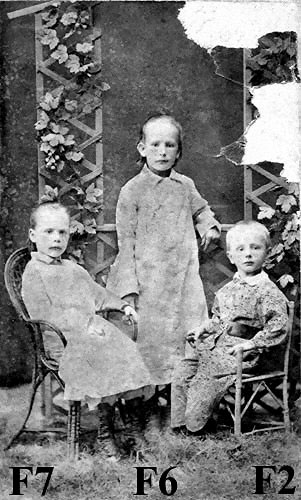
Marie, Elvine-Helene and Constantin Klosse.
He was a high-class professional violinist, artist of the orchestra of Sct.-Peterbourg Maria Theatre. Similarly to his Brother Paul, F4, he highly estimated his German roots and used to confirm his nobility with the particle von: in 'All Peterbourg' of 1899 he is indicated as von Klosse. His addresses were: 1898 - Paulovsk, Prokofyevs' House, 1899 - 8, 6th Ismail Rota, 1900 - 63, Nevsky ave., 1901 - 181, Fontanka, flat 6, 1904 - 24, Sadovaya str., 1907, 1908 - 22, Sadovaya str., 1913 - 90, Sadovaya str.; 1910, 1911, 1912 - absent; the last but one flat was rented by him in the same house on English ave., in which rented the flat the famous Gregory Rasputin, while the last flat No 27 was on 54, Officerskaya str., in the house belonging to Estonian Lutheran Community. In fact, the latter was a corner house with its frontage on Masterskaya, not on Officerskaya str.
View to the house of Estonian Lutheran Community on 54, Officerskaya str. (the biggest building, last on the left in the right part of the photo) from the corner of Torgovaya and Masterskaya. 1959. Old historic building at the corner does not exist any more.
The particle von before
the name of F2 disappeared in later issues of the address-book - with all
probability it was not allowed to him to introduce himself with the voluntary
added particle. In 'All Peterbourg', 1898, he is named 'free artist'. As for the
indication 'artist of Maria Theatre', this appears in the issue of 1913 only. Of
course, the data were presented by himself. All summers he spent at his house on
14, Slavnaya str., in Novgorod, but the main brick house was nationalised and
taken from him by the Bolsheviks after 1917. He remained in the wooden outhouse,
which later became the single dwelling of his son Nicolas, M4, with wife
of the latter Natalie née Strupp, M5, and their son, his grandson, Constantin.4
Klosse, T8. This outhouse also became a summer residence for relatives of
the wife of F2 Maria, F3, i.e. for C5, C4,
i7, H9, H7, Q8,
R1.
Constantin.3 Alexander Klosse, F2, was a perfect pedagogue, he brought up many
violinists. He discovered the talent of H9 and prompted him to learn violin. His
son M4 played violin perfectly, although not prepared for a career of musician.
Much was narrated about peculiar character and oddness of F2. Brought up in a
Lutheran manner, he liked strict order, was pedantic and used to edify others.
One summer in Novgorod he slipped in the garden and smashed a salver with china
after he had just trained his guest i1, wife of his wife's nephew H9, how to
carry porcelain services. H9 and i1 having been married since 1936, this event
took place either in summer 1937, or in 1938, his last summer in Novgorod.
Similarly to A6, he used to cite 'Gaudeamus Igitur' in one of its popular
Russian versions, e.g. the verse Gde vse te, chto v starinu Zhili, veselilis?
Kto - podnyalsya v vyshinu, Kto - spustilsya v glubinu, Vse pereselilis -
the whole text was put down by him into the
diary
CK (former Album of his mother
Laura, B4, initially - Album of her mother
Clara Klosse, A5, in
marriage - Möller). The verse was written in reformed Russian orthography,
i.e. not earlier as in 1917. As an extraordinary personality, F2 was not without
faults. His hobby was card-playing: after 1917, in the period of the so-called
N.E.P., F2 succeeded to win at cards a cinema building in Novgorod. Due to
ill-fated love to a common woman Maria Semyonova dwelling in
Tzarskoe (she was a daughter of Vladimir
Semyonov from the village Vinokhodtsevo of the district Velikiye Luki
in the Governement Pskov), F2 remained a bachelor bringing up his illegitimate children M3 and
M4. Both were legitimised
on October 26, 1907, after the death of their mother on July 20, 1907
(she had drowned herself). As a well-to-do handsome young
nobleman he had luck among women. M4 recollected how his father together with
him called on some woman with Latvian name Zvirblis. This disorderly life
was corrected by his card-playing friend military officer Hasenkampf,
HX, who introduced to F2 Maria Henkel (1878-1962), F3, (see Henkel), sister of Martha Ekimov,
C5, wife of HX' comrade military officer Constantin Ekimov, C4 (see Ekimov).
They married in 1913. Soon M3 (she was
younger than M4) died of syphilis with which F2 with all probability had
infected her mother (this was probably the reason of the suicide of her mother).
He himself avoided any dangerous form of this disease, as well as his wife F3,
who still died in 1962 of progressing paralysis. As for M4, he was not infected as an earlier child. The
worst vice of F2 was his Anti-Semitism with which he satisfied his rancour
against the Bolsheviks. He died of pneumonia in his and his wife's room on
Officerskaya str. in Peterbourg on 1 May 1939.
As said, F2's children were a son Nicolas, M4, born on April 30, 1900, and
a daughter Elisabeth (Lisa), M3, born in Klosse family village Tri Otroka
on February 25, 1903.
Lisa, Maria, Nicolas and Constantin Klosse.
M3’s and M4’s grandmother Laura Klosse, B4, having died in 1908, the children willingly accepted parents of their step-mother F3 as their grandparents, i.e. pastor Karl Henkel, A8, and his wife Martha, A9, - their Christmas postcard, sent to Konin, allows a presumption that F3 had found time to bring them to Konin in 1913.Unfortunately, Lisa, M3 had to die soon. The reason of M3’s death was that F2 rejected all contemporary means of medicine and cured his daughter with hot moist compresses in accordance with recommendations of his late father B1.
Nicolas Klosse (1900-1976), M4, son of F2, was a financist book-keeper. He was married to a Novgorod German Natalie Strupp, M5.
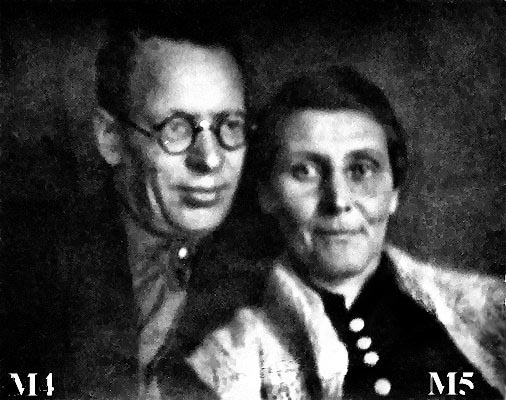
M4 and M5 had the single son Constantin.4, T8, who became a Soviet military engineer. Up to World War II the family dwelled in Novgorod but were evacuated to Altai during the war. Having come back to Novgorod after the war and seen their house burnt, they did not want to restore anything, especially because this was connected with finding property documents of their German ancestors. They moved to Pskov because M4 was proposed a good job there and because Pskov, due to its river Velikaya, seemed to be a substitute for historically similar Novgorod. Velikaya was not as great as Volkhov, of course, but it reminded M4 of his happy childhood. Fishery was his hobby during all his life. He was a good swimmer but he was especially distinguished with his skill to build perfect yachts and schwer-boats on Volkhov as well on Velikaya, too. With his character M4 resembled his father, was pedantic and used to edify others. He spoke slowly, in a singing manner, was stern but not vicious. He and his wife (initially together with their son T8, who later moved to a military school) dwelled in 1 room of a 2-rooms flat in a small one-storey old house, not far from the fall of Pskova into Velikaya, near the Orthodox Cathedral. T8 having graduated, married and sent to job at various towns, M4 and M5 sometimes used to spend summer by their son. Once this was made use of by H7 and his family who spent summer in M4's flat in Pskov. The family of H7 spent several summers near Pskov where M4 had found a tenancy for them in the village of Piskovichi near the delta of Velikaya. The first such summer was in 1948, when the family of H9 participated after the fashion of their pre-war Novgorod experience.
In the delta of Velikaya in 1948 (Natalie Klosse shading her eyes with hand).
Unfortunately, there was no Novgorod-like house and garden in Pskov. Therefore later the family of H9 found better places for their summer rest until finally built their own house near Narva. His wife having died of cancer, Nicolas outlived her several years only. His son T8 dwelling far from Pskov, M4 could not bear the solitude and married an aged Russian woman accidentally met on a cemetery. He moved finally from his old flat to her flat in a big wooden house in another part of the town. Soon after that he died of apoplexy in 1976.
His son Constantin.4 Klosse, T8, inherited his father's fishery hobby and was a good swimmer in his turn, but he was not a boat-master. He broke Peterbourg tradition of his ancestors (which could not exist under his conditions, of course) and married an ethnic Russian woman Palmira, T9, a teacher of Russian literature who was a great Soviet patriot. Strange as it was, T8 finally got to former Tzarskoe Selo (Soviet Pushkin), town of his ancestor druggist Johann Christopher Klosse, 0A. He died there in August 2005. In this way the kin of Klosse found its end on devastated land of its origin.
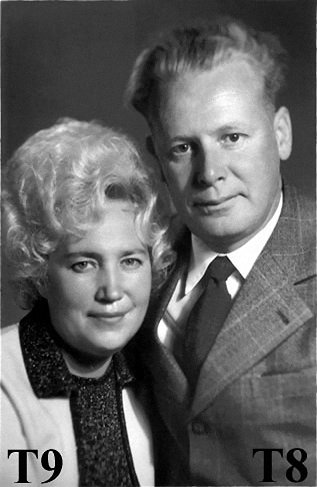
T8 and T9 had a daughter Elena, in marriage - Sokolova, Z2, and a son Nikolai, Z3. The latter dwells together with his wife Tatiana, son Constantin.5 Klosse and daughter Varvara in Tzarskoe. Today Constantin.5 Klosse is engaged in investigating origins of his kin.
The kin of Klosse is related to
that of Ekimov through the marriages of: 1) C4
and C5
> 2) F3 and F2, 3) H7 and H8.
The kin of
Klosse is related to that of Henkel through the marriage of F2 and F3.
The kin of Klosse is
related to that of Tarasenko
through the marriage of
F7 and F8.
